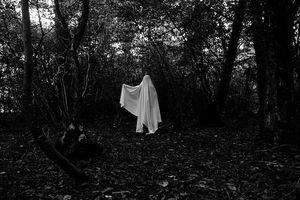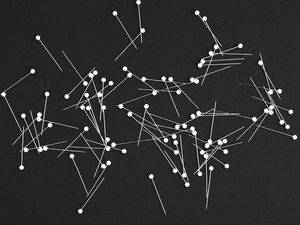Writing For Ghouls
By Peter Counter
It’s spooky season, and here in Atlantic Canada the ambiance is that of a flooded crypt. The smell of wet fallen leaves, rainy days that feel heavy and dark as night, smoke on the air indicating warmth and comfort hidden nearby. Inaccessible. No wonder so many horror genre creators are from the East Coast. This is where the ocean stalks the land, enveloping us in fog, mist, mold, and rot.
If you happen to be one of those horror creators, all this moisture and chill is a prelude to bouts of justification. When the jack O’lanterns nest on porches, genre skeptics come to you seeking answers. “Why horror?” they ask, shifting in their dampened hoodies. “Isn’t the world scary enough?”
The answer is always the same. Yes, the world is full of terror. That’s why we need horror. Horrific media provides us with safe spaces through which we can experience and attempt to understand the negative emotions and thoughts otherwise thrust upon us by atrocity and disaster and political cruelty. To deny horror is to cut yourself off from understanding your own mind and body in difficult times. Horror builds a literacy of self, allowing you to understand the nausea of dread, the flinching anticipation of extreme violence, and the bone aching helplessness of inescapable doom.
Of course, there are also sickos like me that simply find it fun. The chainsaws, the demons, the haunted videotapes. And if neither of those explanations are satisfactory enough, there’s a practical reason to embrace the scary genre too, at least as a writer: to learn the storytelling mechanics that make it so effective.
It Happened to a Friend of a Friend of Mine
Horror often functions through a contrast between the natural order we take for granted and the suspension of scientific laws. This is impossible, but here is what I experienced. Self-doubt, disbelief, surprise, and the uncanny sensation that true reality might not be measurable—these are the tokens of first person horror narrators. If you want to seriously discuss spirituality, faith, or fringe topics that are generally dismissed by the mainstream crowd (like UFOs or alternative medicine), the best way to do so is by framing it as a horror author frames a ghost story.
I find this tool particularly helpful in creative nonfiction. When composing an essay, I am bound to the rules of the world shared by me and my audience, and that is a place with very little hard evidence of the supernatural. But sometimes life doesn’t feel governed by the scientific method, and that can be remarkable. A human experience that doesn’t line up with rational explanation is not the bounds of fiction—sometimes that’s just life. By presenting an anecdote to show divergence from order, you welcome new possibilities, new aesthetics, and new emotions into your nonfiction writing without needing to suspend disbelief or start a self-help cult.
Don’t Look Away, It’s Worse in Your Head
When I was nine, an older kid told me that Pinhead was real. She said that the sadomasochistic hell priest from Clive Barker’s Hellraiser was uncredited because he wasn’t supposed to be in the movie. Apparently he just showed up on set when the film was rolling and the actors improvised. The implication kept me up at night. I saw cardboard cutouts of the pale leatherboy at local video stores, outside the curtain-protected areas containing all the porn and horror. Why did you create Pinhead? I asked God during silent prayer time at my Catholic school. Why do you let him go around torturing us?
My childhood fear kept me from watching Hellraiser for decades while paradoxically trying to learn everything about it by surfing the early internet. I discovered all its terrible combinations of hooks, chains, and skin. In my mind, the film’s suffering was all happening to me in terrible high definition, for eternity, all of it based on vague descriptions with words like “stretching” and “elective surgery.”
Your CanLit News
Subscribe to Open Book’s newsletter to get local book events, literary content, writing tips, and more in your inbox
I finally came around to watching the movie in my thirties. Its infamous gore was shown with crafty practical effects—a beating heart made out of a plastic bag, tearable skin made out of pink latex. Pinhead was only in it for like thirteen minutes, fully credited at the end, and he was very consent-forward. This guy was a role model, not a monster. My fear had built something worse than reality.
Sparsity forces our brains to fill in the gaps, that’s how horror uses our imaginations as a medium. As a writer in any genre the lesson is simple: if you want to activate your reader’s imagination, you need to give them room to add their own detail.
Doomed, All of Us
Just as absence of detail makes the mind grow wilder, a lack of closure opens the reader to feel haunted. While the unhappy ending isn’t ubiquitous in horror, I would argue it’s the most important element of the genre. Horror is pessimist literature, it’s about doing everything right and losing. It’s about seeing answers and finding your own insignificance. It is about subverting the illusion of safety and revealing a landscape of chaos. In that paradigm, there is great value in leaving a reader in the dark. As a writer, the unhappy ending is a tool to use when you want to move your readers to self-reflection.
Sure, an unhappy ending sacrifices reassurance and closure, even moral reward. And those things feel great. But in the place of a final comfort horror leaves room for stories to linger. Truly horrid endings, like the bleak Thai exorcism film The Medium or Paul Tremblay’s heartrending novel The Cabin at the End of the World, paint our existence as unfair but unavoidable. Alive and surviving with no promise of reward, these texts flip the initial question of justification. Skeptics ask, “Why horror?” The answer is manyfold. Horror because of atrocity. Horror because of inequity. Horror because the suffering seems inescapable. In return, with its unhappy endings, horror asks, “Why you?”
The views expressed in the Writer-in-Residence blogs are those held by the authors and do not necessarily reflect the views of Open Book.
Peter Counter is a culture critic writing about television, video games, film, music, mental illness, horror, and technology. He is the author of Be Scared of Everything: Horror Essays and his non-fiction has appeared in the Walrus, All Lit Up, Motherboard, Art of the Title, Electric Literature, and the anthology Empty the Pews: Stories of Leaving the Church. He lives in Dartmouth, Nova Scotia. Find more of his writing at peterbcounter.com and everythingisscary.com.




